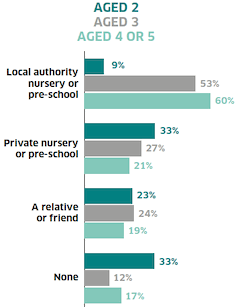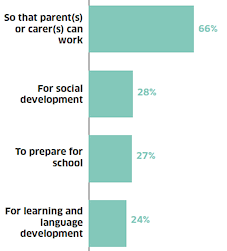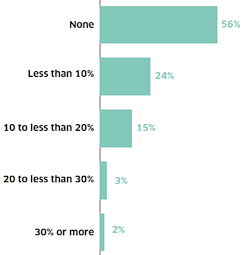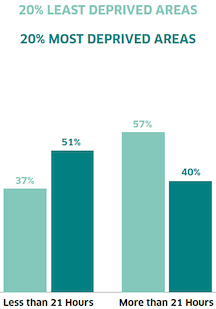Scottish household survey 2019: key findings
An infographic summary of the key findings from the 2019 edition of the Scottish Household Survey, a continuous survey running since 1999 based on a sample of the general population in private residences in Scotland.
This document is part of a collection
Section Thirteen - Childcare
In 2019, 41% of households with children aged two to five used a local authority nursery or pre-school, making it the most common type of childcare.
The second most common type of childcare was private nursery or pre-school, with 27% of households with children using this option.
However, the use of childcare differed depending on the age of the child. For children who were aged two, the most common childcare options were a private nursery or to not use childcare.
However, for children aged 3 or 4 and over, the most common option was a local authority nursery or pre-school.

This bar chart list the most common types of childcare in 2019, and shows the proportion of households using them differentiating between households that have a child aged 2, aged 3 and aged 4 or 5. It highlights that a higher proportion of households with children aged 3 or aged 4 or 5 were more likely to use a local authority nursery or pre-school, while households with a child aged 2 were more likely to use a private nursery or pre-school, or no form a childcare.
In the 20% most deprived areas, 51% of households with children aged two to five used a local authority nursery or pre-school
In the 20% least deprived areas 48% of households with children aged two to five used a private nursery or pre-school
In 2019, the most common reason (66%) for using childcare was to enable the adult or adults in the household to work.
Other common reasons include using childcare for the child’s social development, to prepare them for school and for their learning and language development.
Whether the household is using childcare in order for adults to work varied slightly by area deprivation. 76% of households with children in the 20% least deprived areas reported that they used childcare in order for the adults to work, as opposed to 56% in the most deprived areas.

This bar chart list the most common reasons for using childcare in 2019, as well as the proportion of households using childcare that gave these reasons. In order of how common they were, it lists the following options: “So that the parent(s) or carer(s) can work” (66%), “For social development” (28%), “To prepare for school” (27%), and “For learning and language development” (24%).
84% of carers or parents agreed that their funded childcare provider gave them good ideas for ways to help their child learn
90% agreed that the funded childcare provider communicated with them regularly about their child’s progress
The majority of households in Scotland (56%) did not spend any of their income on childcare, either as it was free or was paid for by the local authority or Scottish Government.
Overall, 24% of households spent less than 10% of their income on childcare.
This differs slightly by household type. 71% of single parent households do not pay anything for their childcare. This compares with 51% of small family households and 61% of large family households.

This bar chart shows the proportion of households using a certain proportion of their income on childcare during school term time. The following categories were used: “None [of the household income was spent on childcare]” (56%), “Less than 10%” (24%), “10 to less than 20%” (15%), “20 to less than 30%” (3%), and “30% or more” (2%). Note that this chart only includes households that use childcare in some capacity.
64% of user households had not had any problems with funded childcare
The most common problems were that there were not enough funded hours (14%), a lack of flexibility in time and days offered (13%), and a lack of provision during school holidays (13%).
It should be noted that the definition of a single parent does not make any distinction between situations where a child has regular contact and/or partly resides with their other parent and a child who solely resides with and is cared for by one parent.
45% of households with children aged two to five used more than 21 hours of childcare every week during school term time.
Households in less deprived areas generally used more childcare hours. In the 20% least deprived areas, 57% used 21 or more hours every week, as opposed to 40% in the 20% most deprived areas.
The proportion of households that used more than 30 hours of childcare every week was significantly larger in the 20% least deprived areas (29%) than in any other deprivation group.

This bar chart shows the proportion of households in the most and least deprived areas that use less than 21 hours of childcare per week during school term time, and those using more than 21 hours. It highlights than more households in the most deprived areas used less than 21 hours per week, while more households in the least deprived areas used more than 21 hours.
38% of households with children aged two to five used no or less than one hour of childcare per week during school holidays
compared with 4% during school term time
Contact
Email: shs@gov.scot
There is a problem
Thanks for your feedback